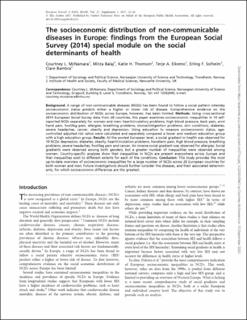| dc.contributor.author | McNamara, Courtney L. | |
| dc.contributor.author | Toch-Marquardt, Marlen | |
| dc.contributor.author | Albani, Viviana | |
| dc.contributor.author | Eikemo, Terje Andreas | |
| dc.contributor.author | Bambra, Clare | |
| dc.date.accessioned | 2021-02-02T09:53:03Z | |
| dc.date.available | 2021-02-02T09:53:03Z | |
| dc.date.created | 2021-01-20T14:50:27Z | |
| dc.date.issued | 2020 | |
| dc.identifier.citation | European Journal of Public Health. 2020, 175, . | en_US |
| dc.identifier.issn | 1101-1262 | |
| dc.identifier.uri | https://hdl.handle.net/11250/2725734 | |
| dc.description.abstract | Background
Social inequalities in non-communicable diseases (NCDs) are evident across all European regions. Employment and working conditions are important determinants of NCDs, however, few comparative studies have examined how these conditions contribute to health inequalities. This study therefore examines the association of non-standard employment and poor working conditions with occupational inequalities in multiple NCDs and whether there are differences by gender and across European regions.
Methods
We used cross-sectional data from 20 European countries for women and men aged 25–75 (n = 19 876), from round 7 of the European Social Survey. Data were analyzed for self-rated health (SRH) and 9 NCDs: heart/circulatory problems, high blood pressure, arm/hand pain, breathing problems, diabetes, severe headaches, cancer, obesity and depression. We used logistic regression models, stratified by gender, and adjusted rate ratios to examine whether occupational inequalities in NCDs were reduced after adjusting for non-standard employment and poor working conditions, across European regions.
Results
After adjustment, occupational inequalities were significantly reduced across all regions of Europe. Reductions were particularly large among the lowest occupational group and for poor-SRH, depression and obesity. For these conditions, reductions were in the range of 60–99%.
Conclusions
Employment and working conditions are important determinants of occupational inequalities in NCDs. Labour market regulations should therefore be considered in the formulation of NCD prevention strategies. | en_US |
| dc.language.iso | eng | en_US |
| dc.publisher | Oxford University Press on behalf of the European Public Health Association. | en_US |
| dc.rights | Attribution-NonCommercial-NoDerivatives 4.0 Internasjonal | * |
| dc.rights.uri | http://creativecommons.org/licenses/by-nc-nd/4.0/deed.no | * |
| dc.title | The contribution of employment and working conditions to occupational inequalities in non-communicable diseases in Europe | en_US |
| dc.type | Peer reviewed | en_US |
| dc.type | Journal article | en_US |
| dc.description.version | publishedVersion | en_US |
| dc.source.volume | 175 | en_US |
| dc.source.journal | European Journal of Public Health | en_US |
| dc.identifier.doi | 10.1093/eurpub/ckaa175 | |
| dc.identifier.cristin | 1875668 | |
| dc.description.localcode | This article is available under the Creative Commons CC-BY-NC-ND license and permits non-commercial use of the work as published, without adaptation or alteration provided the work is fully attributed. | en_US |
| cristin.ispublished | true | |
| cristin.fulltext | original | |
| cristin.qualitycode | 1 | |

